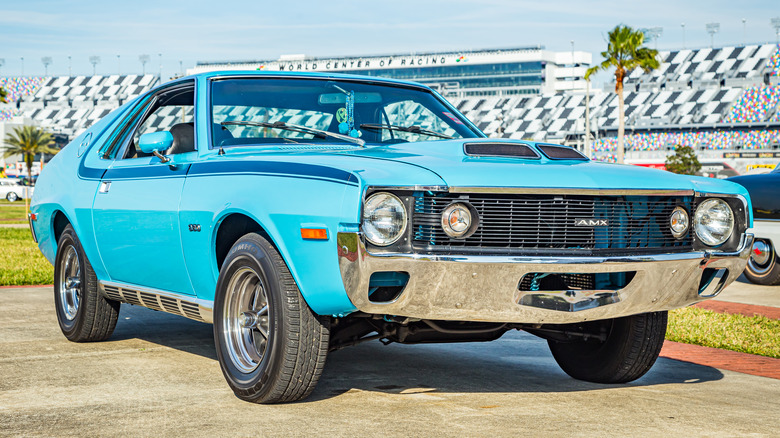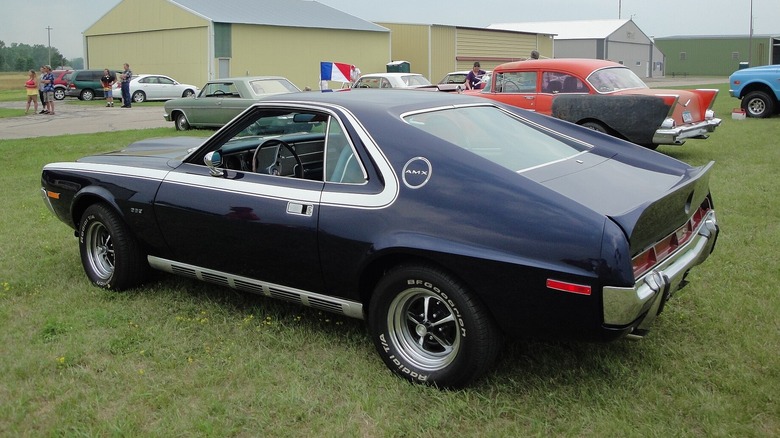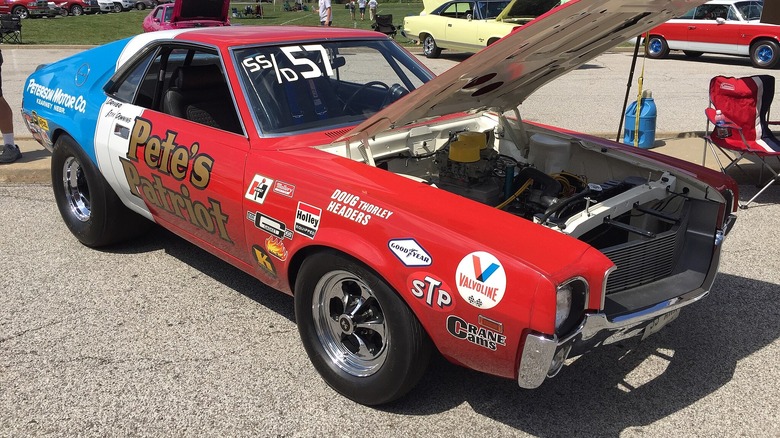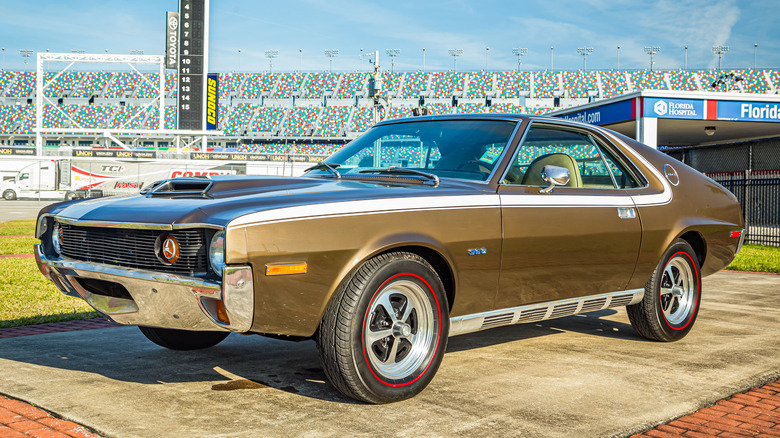The Unsung Hero Of Muscle Cars: The AMC AMX
Miriam-Webster dictionary defines a muscle car as "any of a group of American-made 2-door sports coupes with powerful engines designed for high-performance driving." Of course, sometimes the lines get blurred. Take, for example, the Corvette. Is it a muscle car or a sports car? The oft-forgotten AMX — short for American Motors eXperimental —from American Motors Corporation (AMC) challenged the Corvette in splitting that difference between the muscle car and sports car factions, with blistering straight-line acceleration plus the ability to scoot around a race track with curves in it. And it only had two seats, to boot.
Since its inception, AMC was long the underdog to Detroit's "Big Three" automakers, operating on the margins and with fewer resources. The brand finally found a short-lived foothold in the late sixties with a line of performance machines that reinvented its image as a purveyor of boring basic transportation. At the hands of head designer Dick Teague, the company cranked out striking avant-garde sheet metal like the Javelin, Hornet, Rambler S/C, and AMX.
A peruse through early AMX drawings and photos of concept vehicles shows something much different from the vehicle that would eventually reach production status. In fact, six running prototypes of an exotic mid-engine AMX were built, with coachwork coming from the same Italian firm that supplied Ferrari.
The AMX that was eventually given the greenlight was more humble, based on a shortened (approximately 12 inches) chassis from the brand's successful Javelin pony car, with the rear styling tweaked accordingly for a two-seater. Still, it was the only other American-made two-passenger car besides the Corvette at the time and the first steel-bodied two-seater made in the U.S. since 1957.
It lived up to the hype
Under the AMX's hood lived an array of V8 engines ranging from 290 to 390 cubic inches. The base motor for 1968-1969 was a 290 c.i. V8 making 225 horsepower, but enthusiasts could order the 390 c.i. engine, which boasted 315 horsepower. There was also an intermediate 343 c.i. option available.
For the AMX's final year of 1970, the smaller V8 engines were dropped in favor of a standard 360 cubic inch V8 with 290 horsepower. Buyers could still opt for the 390 c.i. powerplant as well, which now made 325 horsepower courtesy of a new cylinder head design. Transmission choices were limited to a 3-speed automatic or 4-speed manual, the latter of which came with a shifter from performance mogul Hurst from 1969 onward.
During an early road test of a 1968 AMX, Motor Trend piloted a 390 c.i. version of the car to a standing quarter-mile time of 14.6 seconds, which was good enough to hang with all but the most potent muscle cars of the era. Unlike those other muscle cars, the Motor Trend journalists also praised the AMX's handling, calling it "unusually agile and responsive. Performance is exhilarating under any circumstances: on the dragstrip, on a road course, or on a mundane pleasure ride."
AMC returned from its racing absence
Even though the AMX clearly delivered performance on its own merits, AMC executives wanted to solidify this perception before the finished product even hit the streets. To that end, a collaboration was struck with land speed record setter Craig Breedlove to receive a pair of early AMXs on which to work his magic. Prepared by Traco Engineering, the mildly modified cars set an incredible 106-speed record during a short period in early 1968. Perhaps the most impressive accomplishment was when a 390-powered AMX maintained an average speed of nearly 175 miles per hour over a distance of 75 miles, handily breaking the old record of 172 miles per hour.
Next, AMC set its AMX's sights on conquering the drag strip, which it did with a 1969 Super Stock variant in a partnership with Hurst. AMC was required to sell 50 examples of the car to the public to qualify for the NHRA's Super Stock class, and indeed, a total of 52 were snatched up by lucky buyers. Besides chassis modifications, the S/S AMX engines were massaged with higher compression pistons, aftermarket cylinder heads, and a pair of carburetors replacing a stock single unit, among other small tweaks.
AMC claimed a modest 340 horsepower from these motors — 25 horsepower more than a stock 390 cubic inch V8 — but subsequent dynamometer testing revealed more like 500 horsepower. As intended, the specially prepared factory drag racing cars dominated the Super Stock class, with one of the best quarter-mile times recorded by factory driver Shirely Shanan: 10.67 seconds at 125.69 MPH.
The AMX spirit lived on in the Javelin
Unfortunately, the AMX's prowess on drag strips and road racing courses wasn't translating into a high level of sales. By the car's final year of 1970, only 4,116 units were produced — less than half the number that was sold in the prior year. In total, only 19,134 examples of the AMX were sold across all three model years combined. The AMX's languid sales were compounded by management's feeling that it was both costly and silly to produce both the Javelin and the AMX, two cars that were fairly similar and aimed at relatively the same set of buyers.
In a bittersweet conclusion, the AMX nameplate lived on for several more years as a high-performance variant of the Javelin rather than its own separate two-passenger model. In the early 1970s, a Javelin AMX was sampled by the Alabama Highway Patrol as a potential pursuit vehicle, leading to an order for over 130 Javelins by the agency — the first ever use of two-door "pony cars" from any manufacturer as police vehicles. Reportedly, AMC heavily discounted each vehicle that was sold to the highway patrol, a small price to pay for the publicity and bragging rights.



